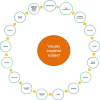A multidisciplinary approach to inherited retinal dystrophies from diagnosis to initial care: a narrative review with inputs from clinical practice
- PMID: 37525225
- PMCID: PMC10388566
- DOI: 10.1186/s13023-023-02798-z
A multidisciplinary approach to inherited retinal dystrophies from diagnosis to initial care: a narrative review with inputs from clinical practice
Abstract
Background: Non-syndromic inherited retinal dystrophies (IRDs) such as retinitis pigmentosa or Leber congenital amaurosis generally manifest between early childhood and late adolescence, imposing profound long-term impacts as a result of vision impairment or blindness. IRDs are highly heterogeneous, with often overlapping symptoms among different IRDs, and achieving a definite diagnosis is challenging. This narrative review provides a clinical overview of the non-syndromic generalized photoreceptor dystrophies, particularly retinitis pigmentosa and Leber congenital amaurosis. The clinical investigations and genetic testing needed to establish a diagnosis are outlined, and current management approaches are discussed, focusing on the importance of the involvement of an interdisciplinary team from diagnosis and initial care to long-term follow-up and support.
Results: The effective management of IRDs requires a multidisciplinary, and ideally interdisciplinary, team of experts knowledgeable about IRDs, with experienced professionals from fields as diverse as ophthalmology, neuropsychiatry, psychology, neurology, genetics, orthoptics, developmental therapy, typhlology, occupational therapy, otolaryngology, and orientation and mobility specialties. Accurate clinical diagnosis encompasses a range of objective and subjective assessments as a prerequisite for the genetic testing essential in establishing an accurate diagnosis necessary for the effective management of IRDs, particularly in the era of gene therapies. Improvements in genome sequencing techniques, such as next-generation sequencing, have greatly facilitated the complex process of determining IRD-causing gene variants and establishing a molecular diagnosis. Genetic counseling is essential to help the individual and their family understand the condition, the potential risk for offspring, and the implications of a diagnosis on visual prognosis and treatment options. Psychological support for patients and caregivers is important at all stages of diagnosis, care, and rehabilitation and is an essential part of the multidisciplinary approach to managing IRDs. Effective communication throughout is essential, and the patient and caregivers' needs and expectations must be acknowledged and discussed.
Conclusion: As IRDs can present at an early age, clinicians need to be aware of the clinical signs suggesting visual impairment and follow up with multidisciplinary support for timely diagnoses to facilitate appropriate therapeutic or rehabilitation intervention to minimize vision loss.
Keywords: Clinical diagnosis; Early-onset retinal dystrophy; Inherited retinal diseases; Leber congenital amaurosis; Molecular diagnosis; Multidisciplinary; Retinitis pigmentosa; Visual function.
© 2023. The Author(s).
Conflict of interest statement
SB, GI, AS, GMB, SB, SS, ST acted as a speakers and consultants at webinars and advisory board meetings organized by Novartis. SF, RC acted as speakers at webinars organized by Novartis. RC acted as consultant for Kedrion, Medivis and Santen.
Figures




References
Publication types
MeSH terms
LinkOut - more resources
Full Text Sources
Research Materials

